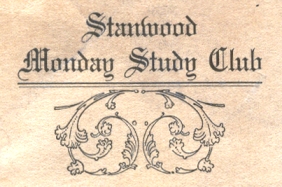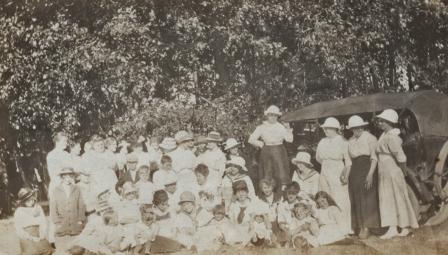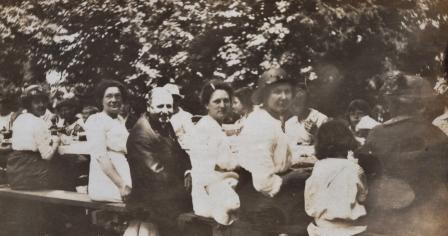“The World is Advancing – Advance with it” –
The Motto of Stanwood’s Monday Study Club
By Nancy Leuschel, May Palmer & Karen Prasse

The Monday Study Club was started in 1913 by a group of Stanwood women to read, study and share what they learned. There was little opportunity for education beyond the 8th grade in Stanwood at that time. It was a really small town – paving of streets with bricks was to begin a year later. The usual means of getting around was by horse and buggy, though a few Ford motor-cars were seen. A public library was not to be built until nine years later. Most of the women lived in the neighborhood that is now the west end of Stanwood near the Stillaguamish River waterfront just north of where the mills and saloons were clustered. Twin City Foods has since replaced the lumbering and shingle businesses that supported the town at the time. To remind us of these days, the 100 year old dilapidated Stanwood Hotel remains along with many of the finer first residences, the D. O. Pearson House, Masons Hall and former Odd Fellows Hall (now the Floyd Norgaard Cultural Center.)
Each year the Monday Study Club chooses an annual theme to study. In the early days they gathered on alternate Mondays after the wash was done at 2 p.m. to share what they learned on their study topic. The group has met continuously since then, still learning from one another and keeping abreast of world events.
There were 17 charter members. Later the membership varied between 12 and 25 and finally settled on 24. Dues at each meeting were 10 cents each meeting in the beginning and are now $10 annually.
In July of 1915, the annual MSC picnic at Ellingson’s Grove above Port Susan was held. Invitations were extended to families and near relatives. The women pretty much had the day to themselves to meet and play. In the evening the men joined the group, a huge bonfire was built, weiner-wurts were toasted; some played games in the light of the camp-fire. The party didn’t break up until 10:00 pm.
Prior to 1928 members were, with few exceptions, always referred to by their husband’s name such as Mrs. John Brown. Nineteen thirty-one was the first year that they were referred to by their given names and in 1938 they reverted to using their husbands’ name. It was not until 1973 that members finally regained their own names for good.Each new member was invited as an opening occurred. This was to make sure that each member had a chance to present a program. Their meetings do not include food because they want to concentrate on the topics of the meeting. Many were very musical; singing was an important part of the meetings.
The Charter members were Ida Brown, Rube Brown, Regina Christianson, Virginia Cook, Florence Durgan, Mabel Holgren, Hattie Howard, Julia Knutson, Sophia Leknes, Elsa Lien, Theresa Dunlap Lien, Marie (Lien) McKean, Tillie Myron, Anna Nicks, Blanche Parsons, Jessie (Hosum) Pearson, and Louise Wenberg. In spite of being addressed the Mrs., if they didn’t have separate careers, many of these women were influential in the schools, businesses and politics of the town. Elsa Lien remembered in an 1973 interview that Blanche Parsons, from Iowa, was an active Women’s Club member and within two years of her arrival, she was the main organizer of the Stanwood Monday Study Club established as a chapter of the Washington State Federation of Women’s Clubs. Monday Study Club was represented at the 1913 Convention of the Snohomish District of the Federation of Women’s Clubs by eight members. Blanche Parsons went to the convention as a delegate and was elected Vice-President of the County Federation.
Though the backgrounds and occupations of the members are more diverse now, several early members worked in addition to raising children. Of the charter members, Louise Wenberg served as Matron of Josephine Sunset Home, later ran for State Legislature as a Farmer Labor Candidate in 1922. She served as Postmistress of the East Stanwood Post Office throughout World War II and assisted in her husband’s career as State Representative. They had a farm in Norman in the Stillaguamish Valley. Jessie Hosum Pearson was a schoolteacher at Utsalady until she married D. Carl Pearson and they moved away. Mrs. Theresa Lien operated a millinery shop in Stanwood among other business and real estate interests. Elsa Matthies Lien worked as a telephone operator for decades and was an advocate of many social causes – she helped establish the local WCTU and often was the sole fund raiser for the Red Cross. Mabel Holgren is listed as a teacher in the 1916 Polk Directory. Harriet Kalloch Howard came to Washington in 1883 from Kansas. Her husband, A. S. Howard was the owner of the Stanwood Lumber Company. Ida Brown, born in Texas was the wife of the local barber was recognized as a tireless advocate and fund raiser for the library. Marie McKean, born in North Dakota was also the wife of a barber. Julie Knutsen never married and worked as a bookkeeper in the First National Bank of Stanwood until she retired. Sophia Leknes is listed as seamstress in the 1916 Polk Directory. We are still seeking more details of the lives of some of the others mentioned.
Members were active in many community organizations, especially the Four-Leaf Clover Club (organized also in 1913 with 19 members) which raised money for the library building. They also promoted town rallies, launched a series of socials, bazaars, dinners and other benefits.

Among their many projects was the refreshment booth during the 5 day Chautauqua of 1916, where they served old-fashioned fried chicken cooked on old-fashioned wood ranges. Their efforts netted $65, a princely sum in the 1916 economy. Generous in their giving, the also contributed to the Education Fund of the Federation, the Belgian Relief Fund, the Chicago Women’s Shelter, the Red Cross.
Minutes of the December 1914 state that MSC puts work first, social occasions after. That said, the club hosted a dinner for 36 (including husbands) in the millinery parlors of Mrs. C.P. Lein, a place big enough to handle to crowd. In 1915, Miss Mary Rauch of the UW Extension Department was asked to hold a 3-day school for housewives – assumed meaning how to be better housewives.” In 1915, The Pictorial Review, a magazine for women, offered to give MSC $150 if they sold 250 subscriptions. The women got right to it, and earned the $150. In 1916, MSC distributed many books to the public and sent a 5-year subscription for “Popular Mechanics” to the state reformatory at Monroe. In 1969, the club discontinued its association with all federations and has since been independent. The Snohomish County Women’s Club itself officially dissolved in 1985.
Currently (2009) there are 17 meetings each year with 12 set aside for talks (2 each time) starting the third Monday in September with the big reveal of the year’s program and our assignments. This meeting is held at a member’s home and is much anticipated. In addition to the 12 meetings with reports there is a Christmas party at a member’s home, a guest day at a restaurant; and the final meeting is a picnic the first Monday in June. The additional meeting is a field day to visit places that relate to the topics: a play when we studied playwrights, river cruise when we studied rivers, visits to a Greek Orthodox Church and St. James cathedral when we studied religions. Those having been members for 20 years may choose to be emeritus members and no longer had to serve on committees or give reports.
The earlier days seemed to be a time of great civility. Pace slower, but the work was harder. Many the Stanwood women then, as now, were born somewhere else and now the members note that no matter what geographic location they study, one of the members has been there. The world is advancing, and they are determined to advance with it 90 years later.
Sources:
“Monday Study Club”, typewritten article Nancy Leuschel, later published in the Stanwood News, 1990s.
Stanwood Monday Study Club, Archival materials, photographs and yearbooks, 1913-2008
Interview with Elsa Matthies Lien, interviewer: Marion Duff; recorded for the Stanwood Area Historical Society, Jan 12, 1973.
Member obituaries, Stanwood News, Twin City News
Snohomish County Federation of Women’s Clubs archival Materials, Snohomish County Museum of History, Everett, Washington.
U.S. Censuses 1910, 1920
© 2009 Monday Study Club, edited for Snocoheritage.org by Karen Prasse, Stanwood Area Historical Society. All Rights Reserved WLP Story #63
